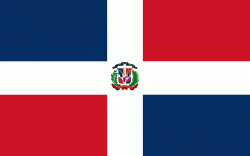Dominican peso
$
Peso dominicano (Dominican peso) has been the name of the currency of the Dominican Republic (República Dominicana) since 2011. Its symbol is "$", with "RD$" used when distinction from other pesos (or dollars) is required; its ISO 4217 code is "DOP". Each peso is divided into 100 centavos ("cents"), for which the ¢ symbol is used. With exception of the United States dollar, it is the only currency that is legal tender in the Dominican Republic for all monetary transactions, whether public or private.Before 2011, peso oro (English: Gold peso) was the official name of the currency of the Dominican Republic.
The first Dominican peso was introduced with the country's independence from Haiti in 1844. It replaced the Haitian gourde at par and was divided into 8 reales. The Dominican Republic decimalized in 1877, subdividing the peso into 100 centavos. A second currency, the franco, was issued between 1891 and 1897 but did not replace the peso. However, in 1905, the peso was replaced by the U.S. dollar, at a rate of 5 pesos to the dollar. The peso oro was introduced in 1937 at par with the U.S. dollar, although the dollar continued to be used alongside the peso oro until 1947.
Country
-
Dominican Republic
The Dominican Republic (República Dominicana, ) is a country located on the island of Hispaniola in the Greater Antilles archipelago of the Caribbean region. It occupies the eastern five-eighths of the island, which it shares with Haiti, making Hispaniola one of only two Caribbean islands, along with Saint Martin, that is shared by two sovereign states. The Dominican Republic is the second-largest nation in the Antilles by area (after Cuba) at 48671 km2, and third-largest by population, with approximately 10.7 million people (2022 est.), down from 10.8 million in 2020, of whom approximately 3.3 million live in the metropolitan area of Santo Domingo, the capital city. The official language of the country is Spanish.
The native Taíno people had inhabited Hispaniola before the arrival of Europeans, dividing it into five chiefdoms. They had constructed an advanced farming and hunting society, and were in the process of becoming an organized civilization. The Taínos also inhabited Cuba, Jamaica, Puerto Rico, and the Bahamas. The Genoese mariner Christopher Columbus explored and claimed the island for Castile, landing there on his first voyage in 1492. The colony of Santo Domingo became the site of the first permanent European settlement in the Americas and the first seat of Spanish colonial rule in the New World. It would also become the site to introduce importations of enslaved Africans to the Americas. In 1697, Spain recognized French dominion over the western third of the island, which became the independent state of Haiti in 1804.
